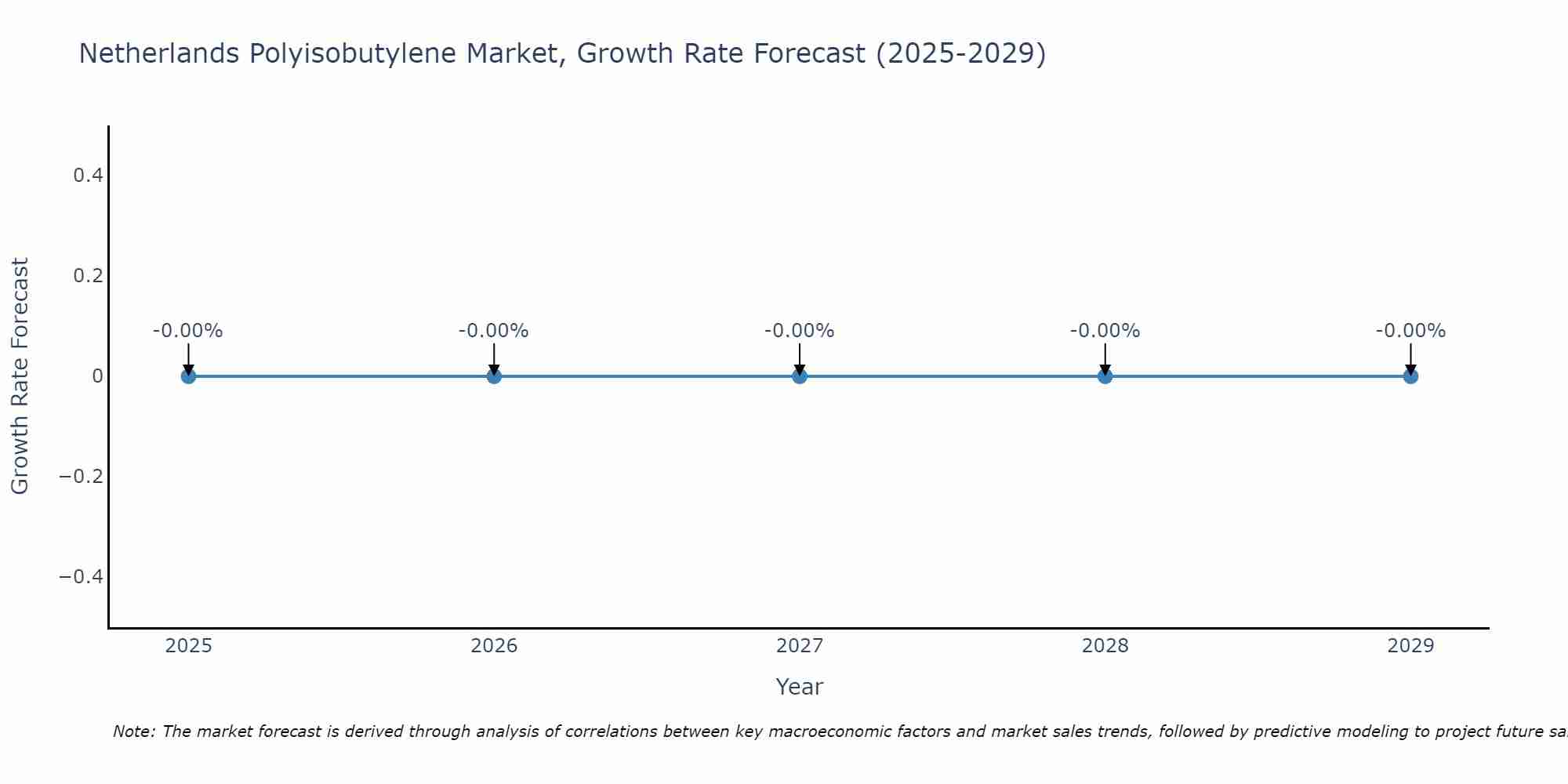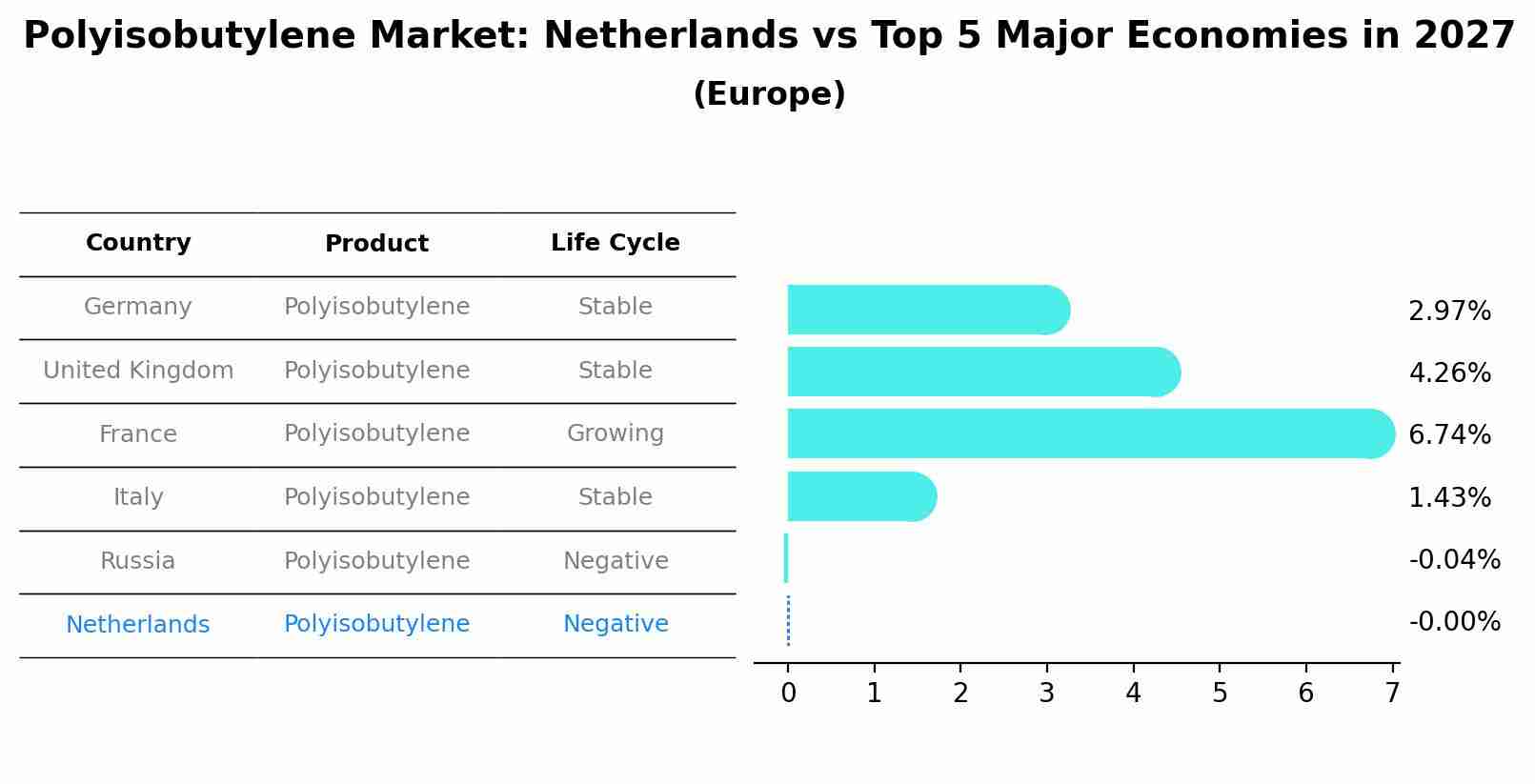Netherlands Polyisobutylene Market (2025-2031) | Revenue, Growth, Trends, Value, Analysis, Forecast, Share, Industry, Size, Outlook, Segmentation & Companies
| Product Code: ETC4750172 | Publication Date: Nov 2023 | Updated Date: Aug 2025 | Product Type: Market Research Report | |
| Publisher: 6Wresearch | Author: Sachin Kumar Rai | No. of Pages: 60 | No. of Figures: 30 | No. of Tables: 5 |
Netherlands Polyisobutylene Market Size Growth Rate
The Netherlands Polyisobutylene Market is projected to witness mixed growth rate patterns during 2025 to 2029. Starting at -0.00% in 2025, the market peaks at -0.00% in 2028, and settles at -0.00% by 2029.

Polyisobutylene Market: Netherlands vs Top 5 Major Economies in 2027 (Europe)
By 2027, the Polyisobutylene market in Netherlands is anticipated to reach a growth rate of -0.00%, as part of an increasingly competitive Europe region, where Germany remains at the forefront, supported by United Kingdom, France, Italy and Russia, driving innovations and market adoption across sectors.

Key Highlights of the Report:
- Netherlands Polyisobutylene Market Outlook
- Market Size of Netherlands Polyisobutylene Market, 2024
- Forecast of Netherlands Polyisobutylene Market, 2031
- Historical Data and Forecast of Netherlands Polyisobutylene Revenues & Volume for the Period 2021-2031
- Netherlands Polyisobutylene Market Trend Evolution
- Netherlands Polyisobutylene Market Drivers and Challenges
- Netherlands Polyisobutylene Price Trends
- Netherlands Polyisobutylene Porter`s Five Forces
- Netherlands Polyisobutylene Industry Life Cycle
- Historical Data and Forecast of Netherlands Polyisobutylene Market Revenues & Volume By Molecular Weight for the Period 2021-2031
- Historical Data and Forecast of Netherlands Polyisobutylene Market Revenues & Volume By Low Molecular Weight Polyisobutylene for the Period 2021-2031
- Historical Data and Forecast of Netherlands Polyisobutylene Market Revenues & Volume By Medium Molecular Weight Polyisobutylene for the Period 2021-2031
- Historical Data and Forecast of Netherlands Polyisobutylene Market Revenues & Volume By High Molecular Weight Polyisobutylene for the Period 2021-2031
- Historical Data and Forecast of Netherlands Polyisobutylene Market Revenues & Volume By Product for the Period 2021-2031
- Historical Data and Forecast of Netherlands Polyisobutylene Market Revenues & Volume By C-PIB for the Period 2021-2031
- Historical Data and Forecast of Netherlands Polyisobutylene Market Revenues & Volume By HR-PIB for the Period 2021-2031
- Historical Data and Forecast of Netherlands Polyisobutylene Market Revenues & Volume By Application for the Period 2021-2031
- Historical Data and Forecast of Netherlands Polyisobutylene Market Revenues & Volume By Tires for the Period 2021-2031
- Historical Data and Forecast of Netherlands Polyisobutylene Market Revenues & Volume By Lube Additives for the Period 2021-2031
- Historical Data and Forecast of Netherlands Polyisobutylene Market Revenues & Volume By Fuel Additives for the Period 2021-2031
- Historical Data and Forecast of Netherlands Polyisobutylene Market Revenues & Volume By 2-stroke Engines for the Period 2021-2031
- Historical Data and Forecast of Netherlands Polyisobutylene Market Revenues & Volume By Industrial Lubes & Others for the Period 2021-2031
- Historical Data and Forecast of Netherlands Polyisobutylene Market Revenues & Volume By Adhesives & Sealants for the Period 2021-2031
- Historical Data and Forecast of Netherlands Polyisobutylene Market Revenues & Volume By End-use Industry for the Period 2021-2031
- Historical Data and Forecast of Netherlands Polyisobutylene Market Revenues & Volume By Transportation for the Period 2021-2031
- Historical Data and Forecast of Netherlands Polyisobutylene Market Revenues & Volume By Industrial for the Period 2021-2031
- Historical Data and Forecast of Netherlands Polyisobutylene Market Revenues & Volume By Food for the Period 2021-2031
- Historical Data and Forecast of Netherlands Polyisobutylene Market Revenues & Volume By Others for the Period 2021-2031
- Netherlands Polyisobutylene Import Export Trade Statistics
- Market Opportunity Assessment By Molecular Weight
- Market Opportunity Assessment By Product
- Market Opportunity Assessment By Application
- Market Opportunity Assessment By End-use Industry
- Netherlands Polyisobutylene Top Companies Market Share
- Netherlands Polyisobutylene Competitive Benchmarking By Technical and Operational Parameters
- Netherlands Polyisobutylene Company Profiles
- Netherlands Polyisobutylene Key Strategic Recommendations
Frequently Asked Questions About the Market Study (FAQs):
1 Executive Summary |
2 Introduction |
2.1 Key Highlights of the Report |
2.2 Report Description |
2.3 Market Scope & Segmentation |
2.4 Research Methodology |
2.5 Assumptions |
3 Netherlands Polyisobutylene Market Overview |
3.1 Netherlands Country Macro Economic Indicators |
3.2 Netherlands Polyisobutylene Market Revenues & Volume, 2021 & 2031F |
3.3 Netherlands Polyisobutylene Market - Industry Life Cycle |
3.4 Netherlands Polyisobutylene Market - Porter's Five Forces |
3.5 Netherlands Polyisobutylene Market Revenues & Volume Share, By Molecular Weight, 2021 & 2031F |
3.6 Netherlands Polyisobutylene Market Revenues & Volume Share, By Product, 2021 & 2031F |
3.7 Netherlands Polyisobutylene Market Revenues & Volume Share, By Application, 2021 & 2031F |
3.8 Netherlands Polyisobutylene Market Revenues & Volume Share, By End-use Industry, 2021 & 2031F |
4 Netherlands Polyisobutylene Market Dynamics |
4.1 Impact Analysis |
4.2 Market Drivers |
4.2.1 Increasing demand for polyisobutylene in the automotive industry for manufacturing of tires, lubricants, and adhesives. |
4.2.2 Growing focus on sustainable and eco-friendly products in various industries, leading to the use of polyisobutylene as a raw material. |
4.2.3 Technological advancements in the production processes of polyisobutylene, enhancing efficiency and reducing costs. |
4.3 Market Restraints |
4.3.1 Fluctuating prices of raw materials used in polyisobutylene production, affecting the overall cost and profitability. |
4.3.2 Stringent regulations and environmental concerns related to the production and usage of polyisobutylene. |
4.3.3 Competition from substitute products and materials in the market, impacting the market share of polyisobutylene. |
5 Netherlands Polyisobutylene Market Trends |
6 Netherlands Polyisobutylene Market Segmentations |
6.1 Netherlands Polyisobutylene Market, By Molecular Weight |
6.1.1 Overview and Analysis |
6.1.2 Netherlands Polyisobutylene Market Revenues & Volume, By Low Molecular Weight Polyisobutylene, 2021-2031F |
6.1.3 Netherlands Polyisobutylene Market Revenues & Volume, By Medium Molecular Weight Polyisobutylene, 2021-2031F |
6.1.4 Netherlands Polyisobutylene Market Revenues & Volume, By High Molecular Weight Polyisobutylene, 2021-2031F |
6.2 Netherlands Polyisobutylene Market, By Product |
6.2.1 Overview and Analysis |
6.2.2 Netherlands Polyisobutylene Market Revenues & Volume, By C-PIB, 2021-2031F |
6.2.3 Netherlands Polyisobutylene Market Revenues & Volume, By HR-PIB, 2021-2031F |
6.3 Netherlands Polyisobutylene Market, By Application |
6.3.1 Overview and Analysis |
6.3.2 Netherlands Polyisobutylene Market Revenues & Volume, By Tires, 2021-2031F |
6.3.3 Netherlands Polyisobutylene Market Revenues & Volume, By Lube Additives, 2021-2031F |
6.3.4 Netherlands Polyisobutylene Market Revenues & Volume, By Fuel Additives, 2021-2031F |
6.3.5 Netherlands Polyisobutylene Market Revenues & Volume, By 2-stroke Engines, 2021-2031F |
6.3.6 Netherlands Polyisobutylene Market Revenues & Volume, By Industrial Lubes & Others, 2021-2031F |
6.3.7 Netherlands Polyisobutylene Market Revenues & Volume, By Adhesives & Sealants, 2021-2031F |
6.4 Netherlands Polyisobutylene Market, By End-use Industry |
6.4.1 Overview and Analysis |
6.4.2 Netherlands Polyisobutylene Market Revenues & Volume, By Transportation, 2021-2031F |
6.4.3 Netherlands Polyisobutylene Market Revenues & Volume, By Industrial, 2021-2031F |
6.4.4 Netherlands Polyisobutylene Market Revenues & Volume, By Food, 2021-2031F |
6.4.5 Netherlands Polyisobutylene Market Revenues & Volume, By Others, 2021-2031F |
7 Netherlands Polyisobutylene Market Import-Export Trade Statistics |
7.1 Netherlands Polyisobutylene Market Export to Major Countries |
7.2 Netherlands Polyisobutylene Market Imports from Major Countries |
8 Netherlands Polyisobutylene Market Key Performance Indicators |
8.1 Research and development investment in new polyisobutylene applications and technologies. |
8.2 Percentage of recycled or sustainable raw materials used in polyisobutylene production. |
8.3 Number of partnerships or collaborations with key industry players to expand market reach and offerings. |
9 Netherlands Polyisobutylene Market - Opportunity Assessment |
9.1 Netherlands Polyisobutylene Market Opportunity Assessment, By Molecular Weight, 2021 & 2031F |
9.2 Netherlands Polyisobutylene Market Opportunity Assessment, By Product, 2021 & 2031F |
9.3 Netherlands Polyisobutylene Market Opportunity Assessment, By Application, 2021 & 2031F |
9.4 Netherlands Polyisobutylene Market Opportunity Assessment, By End-use Industry, 2021 & 2031F |
10 Netherlands Polyisobutylene Market - Competitive Landscape |
10.1 Netherlands Polyisobutylene Market Revenue Share, By Companies, 2024 |
10.2 Netherlands Polyisobutylene Market Competitive Benchmarking, By Operating and Technical Parameters |
11 Company Profiles |
12 Recommendations | 13 Disclaimer |
- Single User License$ 1,995
- Department License$ 2,400
- Site License$ 3,120
- Global License$ 3,795
Search
Thought Leadership and Analyst Meet
Our Clients
Related Reports
- Canada Oil and Gas Market (2026-2032) | Share, Segmentation, Value, Industry, Trends, Forecast, Analysis, Size & Revenue, Growth, Competitive Landscape, Outlook, Companies
- Germany Breakfast Food Market (2026-2032) | Industry, Share, Growth, Size, Companies, Value, Analysis, Revenue, Trends, Forecast & Outlook
- Australia Briquette Market (2025-2031) | Growth, Size, Revenue, Forecast, Analysis, Trends, Value, Share, Industry & Companies
- Vietnam System Integrator Market (2025-2031) | Size, Companies, Analysis, Industry, Value, Forecast, Growth, Trends, Revenue & Share
- ASEAN and Thailand Brain Health Supplements Market (2025-2031) | Strategy, Consumer Insights, Analysis, Investment Trends, Opportunities, Growth, Size, Share, Industry, Revenue, Segments, Value, Segmentation, Supply, Forecast, Restraints, Outlook, Competition, Drivers, Trends, Demand, Pricing Analysis, Competitive, Strategic Insights, Companies, Challenges
- ASEAN Bearings Market (2025-2031) | Strategy, Consumer Insights, Analysis, Investment Trends, Opportunities, Growth, Size, Share, Industry, Revenue, Segments, Value, Segmentation, Supply, Forecast, Restraints, Outlook, Competition, Drivers, Trends, Demand, Pricing Analysis, Competitive, Strategic Insights, Companies, Challenges
- Europe Flooring Market (2025-2031) | Outlook, Share, Industry, Trends, Forecast, Companies, Revenue, Size, Analysis, Growth & Value
- Saudi Arabia Manlift Market (2025-2031) | Outlook, Size, Growth, Trends, Companies, Industry, Revenue, Value, Share, Forecast & Analysis
- Uganda Excavator, Crane, and Wheel Loaders Market (2025-2031) | Strategy, Consumer Insights, Analysis, Investment Trends, Opportunities, Growth, Size, Share, Industry, Revenue, Segments, Value, Segmentation, Supply, Forecast, Restraints, Outlook, Competition, Drivers, Trends, Demand, Pricing Analysis, Competitive, Strategic Insights, Companies, Challenges
- Rwanda Excavator, Crane, and Wheel Loaders Market (2025-2031) | Strategy, Consumer Insights, Analysis, Investment Trends, Opportunities, Growth, Size, Share, Industry, Revenue, Segments, Value, Segmentation, Supply, Forecast, Restraints, Outlook, Competition, Drivers, Trends, Demand, Pricing Analysis, Competitive, Strategic Insights, Companies, Challenges
Industry Events and Analyst Meet
Whitepaper
- Middle East & Africa Commercial Security Market Click here to view more.
- Middle East & Africa Fire Safety Systems & Equipment Market Click here to view more.
- GCC Drone Market Click here to view more.
- Middle East Lighting Fixture Market Click here to view more.
- GCC Physical & Perimeter Security Market Click here to view more.
6WResearch In News
- Doha a strategic location for EV manufacturing hub: IPA Qatar
- Demand for luxury TVs surging in the GCC, says Samsung
- Empowering Growth: The Thriving Journey of Bangladesh’s Cable Industry
- Demand for luxury TVs surging in the GCC, says Samsung
- Video call with a traditional healer? Once unthinkable, it’s now common in South Africa
- Intelligent Buildings To Smooth GCC’s Path To Net Zero


















